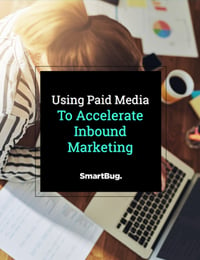
9 Steps for a Successful CPL Campaign
July 27, 2018
By Holly Koch
Paid media is a great opportunity for just about anyone—especially businesses that are just getting started in the world of digital marketing. If your contact database is lacking and you are looking for a relatively quick way to expand your contacts, a cost per lead (CPL) campaign may be perfect for you.
A CPL campaign is when an advertiser pays a publisher any time a user takes an action on the publisher’s website that generates a lead for the advertiser. It is one of several types of pricing models you can choose from in the paid advertising space.
CPL works by either having your content hosted on the publisher’s website and placing it behind a form (gated content) or having the publisher drive traffic to your website’s landing page and tracking how many leads are generated. Any time someone downloads the content, you receive the new lead and you pay the publisher an agreed upon price.
Most likely, you have run across this type of campaign online. If the publisher is following the rules of the Federal Trade Commission, you will see the word “sponsored” next to any display ads or editorial content offers, such as e-books or podcasts.
Let’s take a look at nine steps you can take to run a successful CPL campaign.
Step 1: Decide on the Content to Use and What Audience to Target
Once you have decided that your business is in need of a CPL campaign, go to your content library and find your most popular, currently relevant, or highest converting offer. (I recommend going with your highest converting offer.)
Now that you have chosen your content, ask yourself, who is the target audience for this content? Decide which of your buyer personas would find this content useful in their journey and which stage of the buyer’s journey this content fits into.
After these two things are determined, you are ready to move on to step two.
Step 2: Choose the Publisher
The next step in your campaign is choosing the publisher for your campaign. There are many factors that go into this decision. The main one to consider is target audience.
With CPL campaigns, it is important to go where your target audience is. You should have learned about how your target customer researches information in your buyer persona research. Use this knowledge to determine your options for publishers.
Once you have this information, you’ll have a good list to start with. Start contacting these publishers to see if they run CPL campaigns.
Once you have narrowed down your list, choose the publisher that speaks to your target audience and talk with them about setting up a campaign that targets your ideal customer.
Step 3: Create Custom Targeting
Once you have your publisher chosen, work with them to create and choose custom targeting. This type of targeting can be done several ways. You can target them by geographic location, organization, industry, job title, and more. A lot of your choices for targeting will depend on what data the publisher has been collecting.
Before you finalize your targeting, ask the publisher to exclude your competitors based on company name or email address. This will keep you from paying for your competitors to read your content.
Step 4: Agree on Payment Terms
You have your targeting set! Now you need to figure out how much these leads are going to cost your business. Work with the publisher and agree on a fair price that you will pay the publisher per lead.
The cost usually will depend on the quality of the publisher’s database. This list of the average cost per lead for different industries should help you know where to start when working out the price of your leads.
Step 5: Send Your Assets
Huzzah! You have gotten through the technical aspects of creating a CPL campaign. Now that you have a campaign ready to go, it is time to send the publisher everything they need to support your campaign.
Send the publisher any marketing materials, such as the e-book file, landing page copy, thank you email copy, banner ads, and the information you’d like collected on the landing page form. Ask the publisher if they are able to A/B test your campaign. A/B test things like copy, images, and ads to get the most out of your campaign.
Step 6: Review Your Campaign
Now that the publisher has everything they need from you to set up the campaign, ask the publisher to allow you to review the finished project before it goes live.
When the publisher sends the campaign over, be sure to review it with a fine-toothed comb. I recommend having someone who didn’t help set up the campaign review it as well, in case you are too close to the project.
Once approved, let the publisher know and agree on a launch date.
Step 7: Share the Campaign with Your Network
When the campaign is live, share it on your personal and professional social profiles. Also, consider sending it to your email list and encouraging them to share the content with their own networks.
Aligning your brand with a reputable publisher will help boost your brand awareness and reputation. This will assist you on your quest to establish your organization as a thought leader in the industry.
Step 8: Measure Your Success
Now that your campaign is over, it is time to see how it performed. Were the leads that came from this campaign qualified? Did you generate the amount of leads you were hoping to? Was the CPL within your budget and goals? How can you optimize your campaign for even more success in the future?
After you have thought through all of these factors, determine if your campaign will be considered a success.
Step 9: Rinse and Repeat, if Successful
If your answer was, “Yes! It was a success,” then consider duplicating the campaign with other publishers or allocating more budget to your initial publisher until you start seeing the campaign’s performance decline.
I hope you find these steps helpful. Are there any other steps that you think are important for creating CPL campaigns? Let us know by tweeting us at @smartbugmedia.

About the author
Holly Koch is a Director of Account Strategy at SmartBug Media. She is well-versed in implementing digital marketing strategies for many industries but is particularly passionate about the senior living industry. Outside of work, you'll find Holly traveling with her husband and friends, she is a Cedar Point Amusement Park season pass holder and enjoys hanging out with her cats while working from home. Read more articles by Holly Koch.









